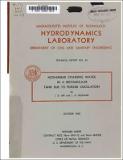| dc.contributor.author | Lin, J. D. | en_US |
| dc.contributor.author | Howard, L. N. | en_US |
| dc.date.accessioned | 2022-06-13T13:12:16Z | |
| dc.date.available | 2022-06-13T13:12:16Z | |
| dc.date.issued | 1960-10 | |
| dc.identifier | 44 | |
| dc.identifier.uri | https://hdl.handle.net/1721.1/143048 | |
| dc.description | Scanning notes: Brittle pages needed to be flatbed scanned. | en_US |
| dc.description | Support of the Office of Naval Research, United States Department of Navy under Contract from Oct. 1959 to June, 1960 Nonr 1841-12. Support of the Office of Naval Research, United States Department of Navy under Contract from July to October, 1960 Nonr 1841(65) | en_US |
| dc.description.abstract | This study is concerned with standing waves generated by a two-dimensional wave maker in a rectangular tank. The theoretical investigation was first based on the well-known linear theory of surface waves. The linearized version of the problem is basically two-dimensional and the solution of forced two-dimensional standing waves of small amplitude was obtained. Then, a system of equations, based on the exact free surface conditions, was derived for solutions of forced two-dimensional standing waves of finite amplitude. A non-linear solution corresponding to any mode of oscillation can in general be obtained by the method of iteration from the system of equations. However, only the fundamental mode was solved here for the velocity potential, free surface elevation and frequency-amplitude relation with the computation carried to the third order of approximation. The frequency amplitude curves for two constant amplitudes of wave maker were found to consist of two non-intersecting branches of oscillation; the range of significant nonlinear effects was also determined for the particular mode. Two profiles of standing waves were computed for the frequencies on each branch of the oscillation. The stability of non-linear forced two-dimensional standing waves was studied by investigating the possibility of excitation of the fundamental mode of cross waves. A system of equations was again derived for solutions of cross waves by extending the method used in the two-dimensional case. The solution corresponding to the first mode of the longitudinal component and the first mode of cross waves was solved by the method of iteration to the second order of approximation, and yields the following results: (1) The half-frequency relation between the cross waves and wave maker, (2) The frequency for excitation of the cross waves, (3) The length/width ratios of the tank at which the cross waves can be excited by an infinitesimal amplitude of wave maker, and (4) The phase relation between the cross waves and the wave maker. The experimental investigation comprises essentially two parts: forced two-dimensional standing waves and cross waves. The experiment of two-dimensional standing waves serves as a verification of the theoretical solutions for both the frequency-amplitude relation and the profile of the standing waves. A satisfactory agreement was indicated in the comparison of the theoretical prediction and of the experimental results. For cross waves, the frequency- amplitude curve was obtained from the experiment in addition to confirming the results of the theoretical analysis above mentioned. | en_US |
| dc.publisher | Cambridge, Mass. : Hydrodynamics Laboratory, Dept. of Civil and Sanitary Engineering, Massachusetts Institute of Technology | |
| dc.relation.ispartofseries | Technical report (Massachusetts Institute of Technology. Hydrodynamics Laboratory) ; no. 44. | |
| dc.title | Non-linear Standing Waves in a Rectangular Tank Due to Forced Oscillation | en_US |
| dc.identifier.oclc | 13883028 | |
| dc.identifier.aleph | 247506 | |
